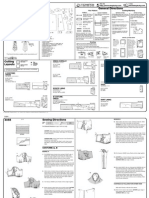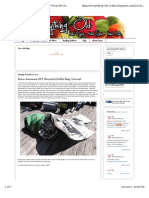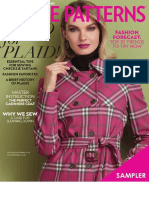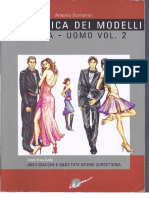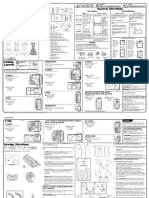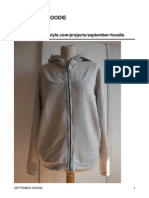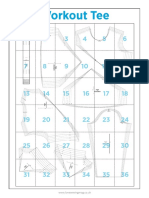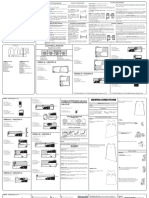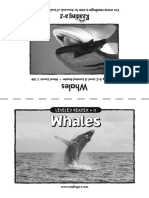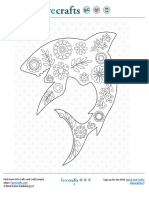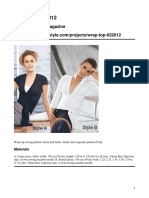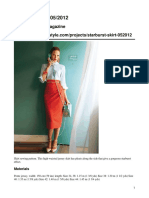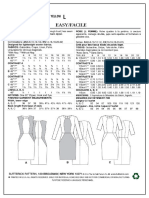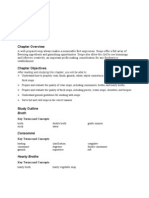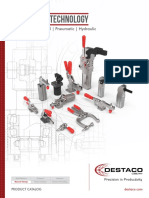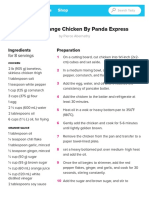How To Use Your Multi Size Pattern Cutting Layouts Sewing Directions
How To Use Your Multi Size Pattern Cutting Layouts Sewing Directions
Uploaded by
didomessiCopyright:
Available Formats
How To Use Your Multi Size Pattern Cutting Layouts Sewing Directions
How To Use Your Multi Size Pattern Cutting Layouts Sewing Directions
Uploaded by
didomessiOriginal Description:
Original Title
Copyright
Available Formats
Share this document
Did you find this document useful?
Is this content inappropriate?
Copyright:
Available Formats
How To Use Your Multi Size Pattern Cutting Layouts Sewing Directions
How To Use Your Multi Size Pattern Cutting Layouts Sewing Directions
Uploaded by
didomessiCopyright:
Available Formats
English/Spanish
3 16
6308 1/4
11 pieces given
1 6
5/8"
9
12
14
U.S. & Canada Toll-Free Web Site E-mail
4 H
1-888-588-2700 http://www.simplicity.com e info@simplicity.com 7
15 17
Thank you for purchasing this New Look pattern. 2
!
5 8 10 11
We have made every effort to provide you with a high quality product. 13
4
Gracias por haber comprado este patrón de New Look.
Hemos hecho todos los esfuerzos para ofrecerle un producto de alta calidad. 1 [
2
6 23
19 20 21 22
5 18
How To Use Your Multi Size Cutting Layouts Sewing Directions
Pattern Cutting Directions Fabric
Key Right Wrong
Interfacing Lining
First Prepare Your Pattern Side Side
Select the pattern pieces according to the view you are FOR FOLDED AND DOUBLE LAYER FABRIC - Place
A B 3 making. fabric with right side inside and pin pattern on wrong side Sew garment following Sewing Directions.
8 7 This pattern is made to body measurements with ease of fabric.
9 allowed for comfort and style. If your body measurements
PIN or machine-baste seams matching notches.
differ from those on the pattern envelope adjust the pieces STITCH 5/8" (1.5cm) seams unless otherwise stated.
FOR SINGLE LAYER - Pin pattern on right side of fabric.
before placing them on the fabric. PRESS seams open unless otherwise indicated, clipping
Check your back neck to waist and dress length, if when necessary so seams will lie flat.
necessary, alter the pattern. Lengthening and shortening NOTE: Pattern pieces may interlock more closely for 14. EASE-STITCH or GATHER - Loosen needle tension
10 lines are indicated. smaller sizes. Cut notches out from cutting line. slightlly. With RIGHT side up, stitch 5/8" (1.5cm) from cut
1. TO LENGTHEN: Cut pattern between printed lines and edge using a long stitch. Stitch again 1/4" (6mm) away in
place paper underneath. Spread pattern the required the seam allowance.
BEFORE removing pattern from fabric, transfer all pattern
amount and pin to paper. EDGE FINISH - Neaten raw edges of seams, hems and
markings using tailor tacks or dressmaking tracing paper.
2. TO SHORTEN: Fold at the printed lines to form a pleat facings using one of the following methods.
11 half the amount to be shortened, ie 1/2’’ (1.3cm) deep to 15. Stitch 1/4” (6mm) from edge, turn under along
shorten 1’’ (2.5cm). 10. KEY: pattern printed side down stitching and stitch.
D 1-FRONT -A,B
C Study Your Pattern Markings 11. KEY: pattern printed side Up 16. Zig-zag or overlock raw edges.
2-SIDE FRONT -A,B,C,D 3. STRAIGHT GRAIN: Place an even distance from 12. KEY: Cut out all pieces except pieces that extend beyond 17. INTERFACING — Pin interfacing to WRONG side of
3-POCKET -A,B selvage or a straight thread. folded fabric, then open out fabric and on RIGHT side of fabric. Cut across corners that will be enclosed with
fabric, cut in positions as shown. seams. Machine-baste 1/2” (1.3cm) from cut edge.
4-BACK -A,B,C,D 4. FOLD: Place on fold of fabric.
13. KEY: For with and without nap layouts ensure fabric is (Shown only on first illustration). Trim interfacing close to
5. LENGTHENING AND SHORTENING LINES. machine-basting. For FUSIBLE interfacing, follow
5-SIDE BACK -A,B,C,D placed with nap or design running in same direction.
6. SEAM ALLOWANCE: 5/8" (1.5cm) unless otherwise manufacturer’s directions.
6-SLEEVE -A,D stated. 18. STAY-STITCH —Stitch 1/2” (1.3cm) from cut edge, in
7-FRONT -C,D Before pinning to fabric, press tissue pattern with a warm direction of arrows: (Shown only in the first illustration).
7. NOTCHES: Match notches.
dry iron to remove creases.
8-POCKET -C,D 8. CUTTING LINES: Multi patterns have different cutting LAYERING — Trim seam allowance in layers.
lines for different sizes. 19. Layer enclosed seams
B 9-FLAP -C,D
A C D 9. TAILOR-TACKS: With double thread make two loose
20. Trim corners
10-TAB -C,D 21. Clip inner curves
stitches forming loop through fabric layers and pattern 22. Notch outer curves
11-GUIDE -C,D leaving long ends. Cut loop to remove pattern. Snip
thread between fabric layers. Leave tufts. 23. UNDERSTITCH —Press facing away from garment;
press seam toward facing. Facing side up, understitch
close to seam through facing and seam allowances.
Español
Cutting Layouts B
5
SELVAGES
10 A USE LAS PIEZAS 1 2 3 4 5 6
USE PIECES 1 2 3 4 5 SELVAGES
3B 58" 60" (150CM)
1 WITH NAP
7 1A 44" 45" (115CM) CON PELUSA
A 2A 44" 45" (115CM)
3 2 8
5
1B 58" 60" (150CM) CON PELUSA
WITH NAP
USE PIECES 1 2 3 4 5 6
2 9
4 4
1A 44" 45" (115CM) B USE LAS PIEZAS 1 2 3 4 5
WITH NAP FOLD FOLD
2A 44" 45" (115CM) CON PELUSA
SELVAGES
2B 58" 60" (150CM) CON PELUSA
3 1
SELVAGES LINING
6
5 3 USE PIECES 2 4 5 7
5
SELVAGES C,D USE LAS PIEZAS 2 4 5 7 8 9 10
2 2B 58" 60" (150CM)
4 1 7 3A 44" 45" (115CM)
WITH NAP
3C 44" 45" (115CM) CON PELUSA
FOLD 5
2 WITHOUT NAP
2 3B 58" 60" (150CM)
3 4 CON PELUSA
4
FOLD
FOLD FORRO USE LAS PIEZAS 2 4 5 7
3C 44" 45" (115CM) SIN PELUSA
SELVAGES
1B 58" 60" (150CM) 3 C,D D CONTRAST SLEEVE
WITH NAP
1 SELVAGES D MANGAS CONTRASTANTES
USE PIECES 2 4 5 7 8 9 10 8 9 SELVAGES USE PIECE 6
6 USE LA PIEZA 6
5
7
3A 44" 45" (115CM) 4 44" 45" (115CM) 6 4 44" 45" (115CM) CON PELUSA
2 WITH NAP 10 WITH NAP
5
4 Selvages=Orillos
2
FOLD 4 Fold=Doblez
FOLD
FOLD
English/Spanish
STAY-STITCHING PATTERN PIECES WILL BE IDENTIFIED BY NUMBERS
6308 2/4 1
THE FIRST TIME THEY ARE BEING USED.
2
SIMPLY THE BEST SEWING TECHNIQUES FOR SIMPLY THE BEST TECHNIQUES FOR
SYNTHETIC SUEDE OR LEATHER-LIKE SEWING FLEECE JACKET A OR VEST B
FABRICS • Fleece fabric is strong, hard to puncture or tear and doesn’t 1. STAY-STITCH front (1) and back (4) neck edges 1/4” (6mm)
• Pin or baste seams within the seam allowance since pin holes remain in ravel or get pilly. from cut edge in direction of arrows.
fabric.
• Since cut edges of fleece fabrics do not ravel, inner edges of POCKETS AND SIDE SEAMS A, B
• Basting tape is another ideal method to hold seam allowances together seams and hems can be left raw.
and avoid slipping of fabric.
• For hand-basting or sewing, use a fine, sharp size 10 needle and a • When pinning pieces together, use long pins...the kind with
2. With RIGHT sides together, pin pocket (3) to front and side
thimble. bead heads are best because short pins tend to get lost in
front (2), matching large dots, having raw edges even. Stitch
the fleece.
• For machine-sewing, use medium but balanced tension and 8 to 10 along 5/8” (1.5cm) seam line.
stitches per inch (2.5cm)...size 11/12 or even a 9/10 ball point needle
• When stitching, try using a narrow zig-zag stitch, adjusting
and 100% polyester or polyester core thread.
the width and length for the type of fleece you are using.
• For top-stitching, use a size 16 needle and silk, polyester buttonhole Always test first on some scraps and keep for reference.
twist or top-stitching thread.
• Sew slowly and carefully the first time you stitch a seam as
• When feeding fabric through machine, hold it “taut” in front of and stitches are hard to remove. 3. Press seam toward pocket, pressing pocket out.
behind the machine needle as you sew. DO NOT stretch. 4
• Press seams open with fingers or press on WRONG side with iron set • To prevent shoulder seams from stretching, pin center of hem
at a low temperature setting and a press cloth. DO NOT USE A STEAM tape or twill tape along seam line on front shoulder edges, 3
IRON. then stitch the shoulder seams.
WE DO NOT RECOMMEND PRESSING ON RIGHT SIDE OF 4. With RIGHT sides together, pin front to side front, matching
FABRIC. When pressing synthetic leather or vinyl, we recommend • When sewing around shaped areas sew slowly being careful large dots, having raw edges even. Stitch, leaving opening
covering your ironing board and garment with brown paper to prevent not to stretch the fleece as you feed fabric through your between large dots, being careful not to catch in pocket
melting. seam; back-stitch at dots to reinforce seam.
machine.
• Always test on fashion fabric scraps.
• Raw edges can also be cut with pinking shears.
Some fabrics may be stubborn to feed through your sewing machine.
Place strips of tissue paper over seams and edges of garment to be • Stitch hems in place 1/4” (6mm) from raw edge.
stitched. Tear away paper after stitching. This method will give you even
stitches without any puckers.
5 5. Press seams open. With RIGHT side together, stitch pocket
GENERAL DIRECTIONS FOR APPLYING edges together between side front seams in a 3/8” (1cm)
DOUBLE FOLD BIAS TAPE OR LEATHER- seam, keeping front out of the way.
LIKE TRIM
DOUBLE FOLD BIAS TAPE- Comes with one side slightly 6
wider than the other. The wider side is used on the INSIDE so
LEATHER-LIKE TRIM that when the tape is stitched in place from the OUTSIDE,
DOUBLE FOLD BIAS TAPE both edges are caught in the stitching.
LEATHER-LIKE TRIM- Fold trim in half, lengthwise, having 6. Press pocket toward front.
one edge extending slightly beyond the other. The wider side
is to be used on the INSIDE so when the trim is stitched in
place from the OUTSIDE, both edges are caught in the
stitching.
APPLYING TAPE OR TRIM- To finish edge, slip the garment
between the folds of the bias tape or edges of trim, placing
the raw edge against the center crease of tape or trim and the
wider edge on the INSIDE of the garment. Stitch the tape or
APPLYING TAPE OR TRIM trim in place from the OUTSIDE, being sure to catch in the
edge on the INSIDE.
7
Curves:
If tape or trim is applied to a curved surface, first, preshape it
with a steam iron. For the trim, you may want to use a cloth to 7. With RIGHT sides together, pin side back (5) sections to
cover the trim. back. Stitch.
INWARD CURVE OUTWARD CURVE Stitch front to back at shoulder seams, matching seams.
Stitch front to back at side seams.
For an inward curve, stretch the double edges and press; for
an outward curve, stretch the fold edge and press.
Ends:
Turn tape ends under to finish or enclose in the seam when
possible.
When tape completely encloses an edge, arrange to have
ends meet at a seam; then turn both ends under where they
meet and tack together invisibly after stitching on tape.
English/Spanish
6308 3/4
14
14. Separate zipper. Place remaining half of zipper on the
8 remaining front section, having zipper face up and teeth even
with front edges, turning under upper ends at large dot, as
shown. Make sure that both sides of zipper are aligned.
Using an adjustable zipper foot, stitch zipper in place along
tape or trim stitching.
8. On OUTSIDE, apply bias tape or trim to front, neck and lower Slip-stitch turned ends in place. Trim away excess upper end
edges, turning under and having ends meet at one side seam of tape, if necessary.
at lower edge. See GENERAL DIRECTIONS FOR TIP- To keep pocket in place, on INSIDE, FRENCH tack front
APPLYING DOULBLE FOLD BIAS TAPE OR LEATHER- edge of pocket to zipper tape.
LIKE TRIM.
VEST C OR JACKET D
SLEEVES A NOTE: Garment can be fastened with button and buttonholes or
STAY-STITCHING decorative snap fasteners.
9. EASE-STITCH top of sleeve (6) between notches. Stitch 1 2
underarm seam.
Press up hem.
9 1. STAY-STITCH front (7) and back (4) neck edges 1/4” (6mm)
Press under 1/4” (6mm) on raw edge.
from cut edge in direction of arrows.
10 Stitch close to inner pressed edge and 1/4” (6mm) below.
10. Turn sleeve RIGHT side out.
2. With RIGHT sides together, stitch side front (2) to front.
Hold garment WRONG side out with armhole toward you.
With RIGHT sides together, pin sleeve to armhole edge with
center small dot at shoulder seam, matching underarm
seams, notches and remaining small dots. Pull up ease
stitches to fit.
To distribute fullness evenly, slide fabric along bobbin threads 3. EDGE FINISH upper edge of pocket (8). Turn upper edge to
until there are no puckers or tucks on the seam line. Baste. INSIDE along fold line, forming facing. Stitch facing close to
Stitch. Stitch again 1/8” (3mm) from first stitching. Trim seam inner edge. Baste side edges together.
below notches close to stitching. Press only the seam
allowance, shrinking out fullness. 4. On OUTSIDE, apply bias tape or trim to side and lower edges
of pocket, turning under ends at upper edge. See GENERAL
DIRECTIONS FOR APPLYING DOULBLE FOLD BIAS
TAPE OR LEATHER-LIKE TRIM.
FINISHING ARMHOLE EDGES B 4
On OUTSIDE, pin pocket to front, placing upper corners at
11. Machine-stitch 3/4” (2cm) from armhole edge of vest. Trim large dots. Stitch along previous stitching on tape or trim.
11 12 3
away 5/8” (1.5cm) from armhole edge. Sew buttons to pocket at small dots or apply knob half of
snap fasteners at small dots, following manufacturer’s
directions.
12. On OUTSIDE, apply bias tape or trim to armhole edge of Illustrations will show buttons and buttonholes.
vest, turning under and having ends meet at side seam at
lower edge. See GENERAL DIRECTIONS FOR APPLYING 5. With WRONG sides together, pin flap (9) sections, having raw
DOULBLE FOLD BIAS TAPE OR LEATHER-LIKE TRIM. 6 edges even. Baste 3/8” (1cm) from raw edges.
5 6. On OUTSIDE, apply bias tape or trim to side and lower edges
of flap. See GENERAL DIRECTIONS FOR APPLYING
DOULBLE FOLD BIAS TAPE OR LEATHER-LIKE TRIM.
ZIPPER A, B
Make buttonholes at markings or apply socket half of snap
13 13. On OUTSIDE, pin front edge of garment over closed zipper, fasteners at center of markings.
having zipper face up and teeth even with front edges, turning On OUTSIDE, pin flap to front, placing basting along flap line,
under upper ends at large dot. Using an adjustable zipper placing edges at small dots, as shown.
foot, stitch zipper in place along tape or trim stitching. 9 Stitch along basting.
7 Trim close to stitching.
TIP: To avoid bumpy stitching around the tab and slider, stop
8 Turn flap down; press.
stitching just before you get to the slider. Leaving the needle
in the fabric, raise the presser foot and pull the slider down
below the needle. Lower the presser foot and continue
7. With RIGHT sides together, stitch tab (10) sections in a
stitching.
3/8” (1cm) seam, leaving end with small and large dots open.
LAYER seam.
8. Turn tab RIGHT side out; press. On OUTSIDE, top-stitch
close to finished edge of tab. Baste raw edges together.
Make buttonhole in tab at marking or apply socket half of
snap fastener at center of marking.
9. On OUTSIDE, pin tab to side edge of side back (5), matching
small and large dots. Baste.
Continue same as for View A or B, see step 7.
English/Spanish
Español CHALECO C O CHAQUETA D
6308 4/4
STAY-STITCHING LAS PIEZAS DEL PATRÓN SE IDENTIFICAN POR NÚMEROS LA
10 11 PRIMERA VEZ QUE SE UTILIZAN. NOTA: La prenda se puede cerrar con botones o broches de presión decorativos.
1. Haga la PUNTADA DE SOSTÈN sobre los bordes del escote delantero (7) y
10. On OUTSIDE, sew buttons to side back at small dots or apply
knob half of snap fasteners at small dots.
CHAQUETA A O CHALECO B trasero(4) desde el borde cortado en dirección de las flechas.
1. Haga la PUNTADA DE SOSTÉN sobre los bordes del escote del frente (1) y de 2. DERECHO CON DERECHO, cosa juntos la parte lateral del frente (2) sobre el
la parte trasera a 1/4” (6mm) del borde cortado en la dirección de las flechas. frente.
3. Haga el ACABADO DEL BORDE sobre le borde superior del bolsillo (8). Doble
BOLSILLOS Y COSTURAS DEL LADO A, B el borde superior al INTERIOR a lo largo de la linea del doblez formando la vista.
Cosa la vista cerca del borde interior. Hilvane juntos los bordes laterales.
2. DERECHO CON DERECHO, prenda con alfileres el bolsillo (3) sobre la parte
11. STAY-STITCH neck edge of lining 1/4” (6mm) from cut edge lateral delantera (4) y el frente (2) casando los puntos grandes y los bordes no 4. Por el DERECHO, aplique la cinta del bies o el adorno sobre los bordes laterales
in direction of arrows. Stitch lining front to side front and back terminados. Cosa a lo largo de la linea de costura de 5/8” (1.5cm). e inferiores del bolsillo doblando los extremos por el borde superior. Vea las
to side back. Stitch side seams and shoulder seams of lining. INSTRUCCIONES GENERALES PARA APLICAR LA CINTA DEL BIES
12 3. Planche la costura hacia el bolsillo y el bolsillo hacia el exterior. DOBLE O EL CUERO SINTÉTICO.
Por el DERECHO, prenda con alfileres el bolsillo sobre el frente colocando las
4. DERECHO CON DERECHO, prenda con alfileres el frente sobre la parte lateral esquinas superiores por los puntos grandes. Cosa a lo largo del pespunte
delantera casando los puntos grandes y los bordes no terminados. Cosa precedente de la cinta o del adorno. Cosa los botones sobre el bolsillo por los
dejando la abertura entre los puntos grandes siendo cuidadoso de no atrapar la puntos pequeños o aplique el broche de presión con hueco por los puntos
costura del bolsillo: retroceda el pespunte por los puntos para reforzar la costura. pequeños, siguiendo las instrucciones del fabricante.
Las ilustraciones mostrarán los botones y los ojales.
12. With WRONG sides together, pin lining to garment, matching 5. Abra las costuras con la plancha. DERECHO CON DERECHO, cosa los bordes
13 del bolsillo juntos entre las costuras de la parte lateral en costura de 3/8” (1cm) 5. REVES CON REVES, prenda con alfileres las secciones de la solapa (9) con los
centers and seams. Baste 3/8” (1cm) from raw edges.
dejando el frente fuera de las costuras. bordes no terminados parejos. Hilvane a 3/8” (1cm) de los bordes no
terminados,
6. Planche el bolsillo hacia el frente.
6. Por el DERECHO, aplique la cinta de biés sobre los bordes laterales e inferiores
7. DERECHO CON DERECHO, prenda con alfileres las partes laterales traseras de la solapa. Vea las INSTRUCCIONES GENERALES PARA APLICAR LA
(5) sobre la parte trasera. Cosa. Cosa juntos el frente sobre la parte trasera por CINTA DEL BIES DOBLE O EL CUERO SINTÉTICO.
13. On OUTSIDE, apply bias tape or trim to front, neck and lower las costuras del hombro casando las costuras. Cosa juntos el frente y la parte Haga los ojales por las marcas o aplique el broche de presión con hueco por el
edges, turning under and having ends meet at one side seam trasera por las costuras del lado. centro de las marcas.
at lower edge. See GENERAL DIRECTIONS FOR 8. Por el DERECHO, aplique la cinta del biés o el adorno sobre los bordes Por el DERECHO, prenda con alfileres la solapa sobre el frente colocando los
APPLYING DOULBLE FOLD BIAS TAPE OR LEATHER- bordes por los puntos pequeños, como se muestra.
delanteros, del escote e inferior doblando y con los extremos que se juntan
LIKE TRIM. sobre la costura del lado por el borde inferior. Vea las INSTRUCCIONES Cosa a lo largo del hilván. Recorte cerca del pespunte. Doble la solapa hacia
GENERALES PARA APLICAR LA CINTA DEL BIES DOBLE O EL CUERO abajo; planche.
SINTÉTICO.
FOR VIEW C- Finish armhole edges same as Vest B, see 7. DERECHO CON DERECHO, cosa las secciones de la solapa (10) en costura de
3/8” (1cm) dejando abierto el extremo con los puntos pequeños y grandes.
steps 11 and 12. Recorta A DIFERENTES NIVELES la costura.
FOR VIEW D- Stitch seams of sleeves same as Jacket A, MANGAS A
see steps 9 and 10. 8. Doble la solapa al DERECHO; planche. Por el DERECHO, cosa con puntadas
9. SOSTENGA la parte superior de la manga (6) entre las muescas. Cosa la de adorno cerca del borde acabado de la solapa. Hilvane juntos los bordes no
costura de debajo del brazo. Planche hacia arriba el dobladillo. Planche un terminados.
doblez de 1/4” (6mm) en el borde no terminado. Cosa cerca del borde interior Haga los ojales sobre la marca de la lengüeta o aplique la parte hueca del
planchado y a 1/4” (6mm) abajo. broche de presión por el centro de la marca.
14
10. Vuelva la manga al DERECHO. Mantenga la prenda sobre el REVES, con la sisa 9. Por el DERECHO, prenda con alfileres la lengüeta sobre el lado de la parte
hacia usted. DERECHO CON DERECHO, prenda con alfileres la manga en la lateral trasera (5) casando los puntos pequeños y grandes. Hilvane.
sisa con el punto pequeño del centro en la costura de los hombros, casando las Siga así como para el Modelo A o B, vea la etapa 7.
costuras del debajo del brazo, las muescas y los puntos pequeños restantes.
Tire de los hilos de frunce para ajustar. Para distribuir la amplitud 10. Por el DERECHO, cosa los botones sobre la parte lateral trasera por los puntos
uniformemente, deslice la tela por los hilos de la canilla hasta que no haya pequeños o aplique la parte con relieve del broche de presión por los puntos
arrugas ni pliegues en la línea de costura. Hilvane. Cosa. Vuelva a coser 1/8” pequeños.
(3mm) del primer pespunte en el margen de costura. Debajo de las muescas,
recorte la costura a ras del pespunte. Planche solamente el margen de la 11. Haga la PUNTADA DE SOSTÉN sobre los bordes del escote del forro a 1/4”
costura, sosteniendo la amplitud. (6mm) del borde cortado en las direcciones de las flechas, Cosa el forro
delantero sobre la parte lateral delantera y la parte rasera sobre la parte lateral
ACABADO DE LOS BORDES DE LA SISA B trasera. Cosa las costuras laterales y del hombro del forro.
14. If pattern length has been altered, respace buttonhole 12. REVES CON REVES, prenda con alfileres el forro sobre la prenda casando los
markings on guide (11). 11. Cosa a máquina a 3/4” (2cm) del borde de la sisa del chaleco. Recorte a 5/8”
centros y las costuras. HIlvane a 3/8” (1cm) de los bordes no terminados.
(1.5cm) desde el borde de la sisa.
FOR BUTTONS- To mark buttonholes in RIGHT front place
12. Por el DERECHO, aplique la cinta de bies o el adorno sobre el borde de la sisa 13. Por el DERECHO, aplique la cinta de biés o el adorno sobre los bordes del
guide along finished edge of garment, matching centers, as
frente, del escote e inferior doblando y con los extremos que se juntan sobre la
shown. Transfer buttonhole markings to garment. del chaleco doblando con los extremos que se juntan por la costura del lado por
costura del lado por el borde inferior. Vea las INSTRUCCIONES GENERALES
el borde inferior. Vea las INSTRUCCIONES GENERALES PARA APLICAR LA
Make buttonholes in RIGHT front at markings. PARA APLICAR LA CINTA DEL BIES DOBLE O EL CUERO SINTÉTICO.
CINTA DEL BIES DOBLE O EL CUERO SINTÉTICO.
Lap RIGHT front over LEFT, matching centers. PARA EL MODELO C- Acabe los bordes de la sisa como para el Chaleco B,
CREMALLERA A, B vea las etapas 11 y 12.
Sew buttons under buttonholes.
PARA EL MODELO D- Cosa las costuras de las mangas como para la
FOR DECORATIVE SNAP FASTENERS- To mark 13. Por el DERECHO, prenda con alfileres el borde delantero de la prenda sobre la Chaqueta A, vea las etapas 9 y 10.
placement for decorative snap fasteners in both fronts, place cremallera cerrada a hacia usted con los dientes parejos con los bordes
guide along finished edge of garment, matching centers, as delanteros doblando los extremos superiores sobre el punto grande. 14. Si el largo del patrón ha sido ajustado, reespacee las marcas para los ojales de
Con un prensatelas ajustable, cosa la cremallera en sitio a lo largo del pespunte la guía (11).
shown. Make a small dot at center of each buttonhole
de la cinta o del adorno. PARA LOS BOTONES - Para hacer los ojales del frente DERECHO, coloque la
marking. Transfer small dots to both fronts.
CONSEJO: Para evitar una costura irregular alrededor de la jaladera, pare el guía a lo largo del borde acabado de la prenda, casando los centros, como se
Apply snap fasteners to garment, following manufacturer's pespunte antes de llegar a la jaladera. Dejando la aguja en la tela, levante el muestra.
directions. prensatelas y tire la jaladera por abajo, debajo de la aguja. Baje el prensatelas y Haga los ojales en el frente DERECHO por las marcas.
siga pespunteando.
Cruce el frente DERECHO sobre el IZQUIERDO casando los centros.
14. Abra la cremallera. Coloque la otra parte de la cremallera sobre la sección Cosa los botones debajo de los ojales.
delantera hacia usted y con los dientes y los bordes parejos doblando los PARA LOS BROCHES DE PRESIÓN DECORATIVOS- Para marcar la
extremos superiores por el punto grande, como se muestra. Asegúrese que colocación de los broches de presión decorativos sobre ambos frentes, coloque
ambos lados de la cremallera. Con un prensatelas ajustable, cosa la cremallera la guía a lo largo del borde acabado de la prenda casando los centros, como se
en sitio a lo largo del pespunte de la cinta o del adorno. muestra. Haga un punto pequeño por el centro de la marca para el ojal. Reporte
Cosa con puntadas falsas los extremos en sitio. Recorte el extremo superior los puntos pequeños sobre ambos frentes.
excedente de la cinta, si necesario. Aplique los broches de presión sobre el prenda siguiendo las instrucciones del
CONSEJO- ¨Para mantener el bolsillo en sitio, por el INTERIOR, fije de manera fabricante.
SUELTA el borde delantero del bolsillo sobre la cinta de la cremallera,
You might also like
- Black Book Samsung FinalDocument69 pagesBlack Book Samsung FinalKrinal Shah60% (15)
- Methods of Test For ButtonsDocument4 pagesMethods of Test For ButtonsmomofattohNo ratings yet
- Sim 5581 InstructionsDocument4 pagesSim 5581 InstructionsLinh KurtNo ratings yet
- Simplicity Pattern 4055 InstructionsDocument3 pagesSimplicity Pattern 4055 Instructionsangeleyes88100% (2)
- Final Presentation H&M (Again)Document36 pagesFinal Presentation H&M (Again)Phạm Kim Kim67% (3)
- Sim 1609Document4 pagesSim 1609didomessiNo ratings yet
- 4014 General Directions: Cutting/Marking The PatternDocument4 pages4014 General Directions: Cutting/Marking The PatterndidomessiNo ratings yet
- 4014 General Directions: Cutting/Marking The PatternDocument4 pages4014 General Directions: Cutting/Marking The PatterndidomessiNo ratings yet
- Diy Sail BagDocument7 pagesDiy Sail Bagደጀን ኣባባNo ratings yet
- Vogue PatternsDocument12 pagesVogue PatternsAce Miel0% (3)
- Seam PuckeringDocument16 pagesSeam PuckeringIshika100% (3)
- New Look 6067 InstructionsDocument4 pagesNew Look 6067 InstructionsdidomessiNo ratings yet
- New 6301Document3 pagesNew 6301didomessiNo ratings yet
- How To Use Your Multi Size Pattern Cutting Layouts Sewing DirectionsDocument4 pagesHow To Use Your Multi Size Pattern Cutting Layouts Sewing DirectionsdidomessiNo ratings yet
- 485 Pencil Skirt Ebook PDFDocument19 pages485 Pencil Skirt Ebook PDFBiswajit Paul100% (1)
- 1463 General Directions: Bodice Back and SleevesDocument4 pages1463 General Directions: Bodice Back and SleevesTammy SwensonNo ratings yet
- Sim2741 InstructionDocument4 pagesSim2741 InstructionLinh KurtNo ratings yet
- Sim 5189Document4 pagesSim 5189smug97No ratings yet
- Sim 4236Document3 pagesSim 4236smug97No ratings yet
- Women Vest PDFDocument2 pagesWomen Vest PDFPakistanNo ratings yet
- Madame Cadolle - Custom BrasDocument6 pagesMadame Cadolle - Custom BrasIread2enlightenNo ratings yet
- Sleeves Design IdeaDocument39 pagesSleeves Design IdealizaNo ratings yet
- Winning Spirit - WorkwearDocument64 pagesWinning Spirit - WorkwearJasper Hazlett100% (1)
- GabrielleJacket PatternDocument41 pagesGabrielleJacket Patterndaisy22No ratings yet
- Pattern Making SoftwareDocument2 pagesPattern Making Softwareinama33100% (1)
- 4072 0614 General Directions: Cutting/Marking The PatternDocument4 pages4072 0614 General Directions: Cutting/Marking The PatternAriamna ZambranoNo ratings yet
- 010 Capitulo 10Document23 pages010 Capitulo 10whilmeragudeloNo ratings yet
- Garment Technology EbooksDocument24 pagesGarment Technology Ebooksmithonlink100% (1)
- Setting Godets in Pencil SkirtsDocument29 pagesSetting Godets in Pencil SkirtsDamaris G100% (2)
- Vebuka La Tecnica Dei Modelli Uomo Donna Volume 2Document255 pagesVebuka La Tecnica Dei Modelli Uomo Donna Volume 2Mohsen RasouliNo ratings yet
- Customized Dress FormDocument8 pagesCustomized Dress FormAmandaNo ratings yet
- Frida Huipil InstructionsDocument6 pagesFrida Huipil InstructionsChapo ThomasNo ratings yet
- Drafting A Sleeve Cap HandoutDocument5 pagesDrafting A Sleeve Cap Handoutfrapatch100% (1)
- 2907 General Directions: Cutting/Marking The PatternDocument4 pages2907 General Directions: Cutting/Marking The PatternNereida GuerreroNo ratings yet
- #5129 Dress InstructionDocument2 pages#5129 Dress Instructionmr kdrama0% (1)
- 2443 General Directions: Cutting/Marking The PatternDocument4 pages2443 General Directions: Cutting/Marking The PatterndidomessiNo ratings yet
- Easy Glove Pattern PayhipDocument7 pagesEasy Glove Pattern PayhipRedmi RemeNo ratings yet
- NovelDocument15 pagesNovelJohn DoverNo ratings yet
- Simplicity 1103 InstructionsDocument4 pagesSimplicity 1103 InstructionsdidomessiNo ratings yet
- 2337 General Directions: Cutting/Marking The PatternDocument4 pages2337 General Directions: Cutting/Marking The PatterndidomessiNo ratings yet
- Cloth Habit 1001 Ladyshorts InstructionsDocument4 pagesCloth Habit 1001 Ladyshorts InstructionsRomina DanieleNo ratings yet
- Pdfanddoc 134644 PDFDocument76 pagesPdfanddoc 134644 PDFshafizza syed hodNo ratings yet
- Extended Front Dart 1Document31 pagesExtended Front Dart 1John DoverNo ratings yet
- VV Bias Slip Text1Document4 pagesVV Bias Slip Text1shafizza syed hodNo ratings yet
- PuffSleeve by DariaPatternmakingDocument6 pagesPuffSleeve by DariaPatternmakingAlwaysquine SabrineNo ratings yet
- COLOR The Ultimate Guide To Digital Sewing Patterns With Included Skirt PatternDocument23 pagesCOLOR The Ultimate Guide To Digital Sewing Patterns With Included Skirt Patternsandroca100% (2)
- C228 PDFDocument8 pagesC228 PDFtemplarhistri18No ratings yet
- Unit 5 FabricDocument22 pagesUnit 5 Fabricina gastadorNo ratings yet
- The Essential Guide To Sewing With LaceDocument2 pagesThe Essential Guide To Sewing With LaceamyNo ratings yet
- Chrissi Jo: Printing Cleo CollectionDocument19 pagesChrissi Jo: Printing Cleo CollectionFlávia CamposNo ratings yet
- Swimwear 1Document29 pagesSwimwear 1Priya Ghosh100% (1)
- September Hoodie OriginalDocument2 pagesSeptember Hoodie OriginalClau NarváezNo ratings yet
- Step-By-Step Guide To Bound Buttonhole Patch Method: Closures: Zippers, Buttonholes & Loops With Nicki LafoilleDocument3 pagesStep-By-Step Guide To Bound Buttonhole Patch Method: Closures: Zippers, Buttonholes & Loops With Nicki LafoilleSarah WordenNo ratings yet
- Colette Patterns - Rue New BodiceDocument28 pagesColette Patterns - Rue New BodiceAnne Huang100% (1)
- Bella Corset Sewing InstructionsDocument15 pagesBella Corset Sewing Instructionschantell.fourieNo ratings yet
- 017 Capitulo 17Document15 pages017 Capitulo 17whilmeragudeloNo ratings yet
- Linen Pants Construction DiagramDocument1 pageLinen Pants Construction DiagramVishnu Priya SahasranamanNo ratings yet
- Alvanon Standard Global MEN: US Uk / Au de / NL / DK / Se FR / Es / ItDocument4 pagesAlvanon Standard Global MEN: US Uk / Au de / NL / DK / Se FR / Es / ItFlorin DiegisNo ratings yet
- (KT) Bolsa Toallas HigienicasDocument20 pages(KT) Bolsa Toallas HigienicasMaria RodriguezNo ratings yet
- EsarfeDocument182 pagesEsarfeCirnu Alina100% (4)
- Cme Ebook 10Document19 pagesCme Ebook 10MarittaKarma100% (1)
- Simplicity 1102 InstructionsDocument4 pagesSimplicity 1102 InstructionsdidomessiNo ratings yet
- Potatoes and Human HealthDocument19 pagesPotatoes and Human HealthIliaNo ratings yet
- Carly WB NL PDFDocument6 pagesCarly WB NL PDFdidomessiNo ratings yet
- Bluzka 36-48 EvroDocument24 pagesBluzka 36-48 EvrodidomessiNo ratings yet
- Pullover Pattern XXS-XLDocument37 pagesPullover Pattern XXS-XLdidomessiNo ratings yet
- ksp3882 1Document1 pageksp3882 1didomessiNo ratings yet
- M MC CC CA Allll''S S: Cutting LayoutsDocument3 pagesM MC CC CA Allll''S S: Cutting LayoutsdidomessiNo ratings yet
- 7516 Instruc Blouse Sina ENDocument1 page7516 Instruc Blouse Sina ENdidomessiNo ratings yet
- ksp3882 1Document1 pageksp3882 1didomessiNo ratings yet
- Cutting Layouts: Dress A / Vestido ADocument3 pagesCutting Layouts: Dress A / Vestido AdidomessiNo ratings yet
- Color Outside The Lines Adult Coloring Page PDFDocument1 pageColor Outside The Lines Adult Coloring Page PDFdidomessiNo ratings yet
- Reading Book For Children - Shadow PeopleDocument10 pagesReading Book For Children - Shadow PeopledidomessiNo ratings yet
- How To Use Your Multi Size Pattern Cutting Layouts Sewing DirectionsDocument4 pagesHow To Use Your Multi Size Pattern Cutting Layouts Sewing DirectionsdidomessiNo ratings yet
- Whales - Reading Book For ChildrenDocument16 pagesWhales - Reading Book For ChildrendidomessiNo ratings yet
- 2337 General Directions: Cutting/Marking The PatternDocument4 pages2337 General Directions: Cutting/Marking The PatterndidomessiNo ratings yet
- Floral Shark Coloring PageDocument1 pageFloral Shark Coloring PagedidomessiNo ratings yet
- Ruched Sheath Dress 052012 - OriginalDocument5 pagesRuched Sheath Dress 052012 - Originaldidomessi100% (1)
- 2409 General Directions: Cutting/Marking The PatternDocument4 pages2409 General Directions: Cutting/Marking The PatterndidomessiNo ratings yet
- Princess Seam Pencil Skirt 04/2012: By: Burda Style MagazineDocument4 pagesPrincess Seam Pencil Skirt 04/2012: By: Burda Style MagazinedidomessiNo ratings yet
- Simplicity 1103 InstructionsDocument4 pagesSimplicity 1103 InstructionsdidomessiNo ratings yet
- Simplicity 1102 InstructionsDocument4 pagesSimplicity 1102 InstructionsdidomessiNo ratings yet
- Chili's Boneless Shanghai WingsDocument2 pagesChili's Boneless Shanghai WingsdidomessiNo ratings yet
- Chocolate Marquise - BBC Good FoodDocument1 pageChocolate Marquise - BBC Good FooddidomessiNo ratings yet
- Wrap Top 03/2012: By: Burda Style MagazineDocument5 pagesWrap Top 03/2012: By: Burda Style MagazinedidomessiNo ratings yet
- 12/2011 Trench Coat: By: Burda Style MagazineDocument6 pages12/2011 Trench Coat: By: Burda Style Magazinedidomessi100% (1)
- Starburst Skirt 052012 - OriginalDocument4 pagesStarburst Skirt 052012 - Originaldidomessi100% (1)
- But 6088Document1 pageBut 6088didomessi0% (1)
- 12/2012 V-Neck Dress: By: Burda Style MagazineDocument5 pages12/2012 V-Neck Dress: By: Burda Style Magazinedidomessi100% (2)
- Chapter Overview: BrothDocument5 pagesChapter Overview: BrothBeb HaqNo ratings yet
- Prime Tex-BD ProfileDocument5 pagesPrime Tex-BD ProfileMoshior RohmanNo ratings yet
- DABURDocument37 pagesDABURSA AvinashNo ratings yet
- Summer Clothes-Haine de VaraDocument1 pageSummer Clothes-Haine de VaraneliaNo ratings yet
- Grade 8 Spanish Week 1 Lesson 1 and AnswersheetDocument7 pagesGrade 8 Spanish Week 1 Lesson 1 and AnswersheetRebbieNo ratings yet
- DESTACO Clamping Technologies CatalogDocument364 pagesDESTACO Clamping Technologies CatalogAnonymous oTrMzaNo ratings yet
- Mother's Day Sample ChapterDocument12 pagesMother's Day Sample ChapterQuercus BooksNo ratings yet
- DK in Tars I A Instructions SnoopyDocument1 pageDK in Tars I A Instructions SnoopyshaunNo ratings yet
- BandsawDocument11 pagesBandsawTrung Quoc LeNo ratings yet
- @soliqnews: Eksport Shartnomalari Bo Yicha Muddati o Tgan Debitor Qarzdorligi Bo Lmagan - Intizomli Soliq To LovchilarDocument21 pages@soliqnews: Eksport Shartnomalari Bo Yicha Muddati o Tgan Debitor Qarzdorligi Bo Lmagan - Intizomli Soliq To Lovchilarusmonovusmonjon71No ratings yet
- RETAILDocument20 pagesRETAILPorkodi SubramaniyamNo ratings yet
- Original Orange Chicken by Panda Express Recipe by TastyDocument2 pagesOriginal Orange Chicken by Panda Express Recipe by TastyQuentinNo ratings yet
- Adjectives Word Order - 56231Document2 pagesAdjectives Word Order - 56231Dewi Lisna100% (1)
- Perator S Anual: Zero-Turn Tractor Lapbar Drive Control LeversDocument48 pagesPerator S Anual: Zero-Turn Tractor Lapbar Drive Control LeversJames LoewenNo ratings yet
- Bread Revolution by Peter Reinhart - RecipesDocument12 pagesBread Revolution by Peter Reinhart - RecipesThe Recipe Club57% (21)
- Grinder Safety: Portable Grinders Stationary GrindersDocument7 pagesGrinder Safety: Portable Grinders Stationary GrindersbigappforfunNo ratings yet
- A DeelDocument2 pagesA DeelAmaraaZoyaNo ratings yet
- Onscam Stage Cargo Shorts PG 6689Document3 pagesOnscam Stage Cargo Shorts PG 6689Kimberly GrantNo ratings yet
- PSIS Waltermart Outright - Maintenance TableDocument16 pagesPSIS Waltermart Outright - Maintenance TableMaxine Ivana Agustin GamutanNo ratings yet
- Aqua Flo RO ManualDocument24 pagesAqua Flo RO ManualPedro LacerdaNo ratings yet
- Section 1 Completed: Case Study Exam - Section 2 TaskDocument6 pagesSection 1 Completed: Case Study Exam - Section 2 TaskchetandeepakNo ratings yet
- Washing Machine Service Manual: MODEL: 796.4051#90#Document59 pagesWashing Machine Service Manual: MODEL: 796.4051#90#HONGNo ratings yet
- Increase in Ad Spend by HaierDocument2 pagesIncrease in Ad Spend by HaierASHISHNo ratings yet
- Lifting and Removing Using The Forklift or Telescopic Loader in SiteDocument3 pagesLifting and Removing Using The Forklift or Telescopic Loader in SiteAMINNo ratings yet
- Rutini Wines Website Revision - 9oct 2012Document17 pagesRutini Wines Website Revision - 9oct 2012Daniel Perez OjedaNo ratings yet
- Channel Flow, Design and FunctionsDocument19 pagesChannel Flow, Design and FunctionsAvichal MehrotraNo ratings yet



